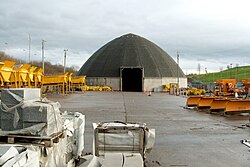Nitshill
| Nitshill | |
| Renfrewshire | |
|---|---|
 Nitshill Depot | |
| Location | |
| Grid reference: | NS528602 |
| Location: | 55°48’45"N, 4°21’2"W |
| Data | |
| Post town: | Glasgow |
| Postcode: | G53 |
| Local Government | |
| Council: | Glasgow |
| Parliamentary constituency: |
Glasgow South |
Nitshill is a village of Renfrewshire which has accreted to the Glasgow conurbation and become a district on the south side of that city, north of South Nitshill and south of Crookston.
Nitshill was originally a coal-mining village. The Nitshill Colliery was the scene of one of Britain's worst mining disasters, on 15 March 1851 in which 61 men and boys died.
In the 1920s the civic boundaries of the city were extended to encompass Nitshill and its neighbours, to allow the extension of the urban area's education and community services, and so that residential estates could be built.
The village grew to accommodate people relocated during the Glasgow slum clearances in the 1950s and 1960s. The village became a low socio-economic area on the main Glasgow-Kilmarnock road and rail networks. However, there has been a move towards improving the district with the building of The Glasgow Museums Resource Centre, which houses the Nitshill Open Museum. This is a new purpose-built museum storage facility and visitor centre.
The poet and folk singer Jock Purdon was born and grew up in Nitshill.
Househill Mansion
Househill Mansion was built in the early 19th century to replace an earlier house on the lands of Househill belonging to the Dunlop family. It became the home of John Cochrane and his wife Catherine Cranston, proprietor of Miss Cranston's Tearooms including the Willow Tearooms designed by Charles Rennie Mackintosh.
In 1904, Mrs Cochrane commissioned Mackintosh to re-create the interior of her home, including redecoration of rooms, provision of new fire-surrounds and design of furniture. One end of the music room was semicircular in plan, and he extended the shape into the room with a horizontal rail at picture rail height about two feet clear of the curved wall which continued round into the room space to complete the circle. This horizontal circle was supported on a curved screen of narrow vertical slats for much of its length in the room, and on fittings against the wall which incorporated benches and window seats in his typical style. The centre of the circle was marked by a similarly slatted light fitting hanging from the ceiling. Catherine Cranston sold the house in 1920 after her husband died. The house was demolished around 1930 after being badly fire damaged.
Victoria coal pit disaster
On 15 March 1851 an explosion at the Victoria coal pit killed 61 of the 63 men and boys in the mine at the time. Two survivors were rescued 45 hours after the explosion.[1]
Outside links
- ↑ Nitshill 15 March 1851 scottishmining.co.uk, accessed 10 February 2010
- Glasgow Museums Resource Centre & Nitshill Open Museum
- TheGlasgowStory: Househill (Hous'hill)
- TheGlasgowStory: Furniture from Hous'hill
References
- Robert Macleod, Charles Rennie Mackintosh, Country Life Books 1968